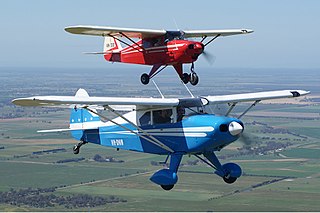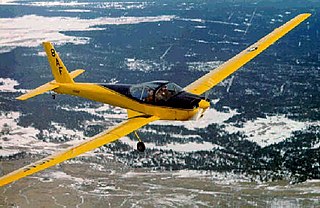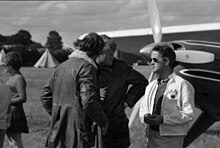
The Piper PA-23, named Apache and later Aztec, is an American four- to six-seat twin-engined light aircraft aimed at the general aviation market. The United States Navy and military forces in other countries also used it in small numbers. Originally designed as the Twin Stinson in the 1950s by the Stinson Aircraft Company, Piper Aircraft manufactured the Apache and a more powerful version, the Aztec, in the United States from the 1950s to the 1980s.

The Cessna 120,140, and 140A, are single-engine, two-seat, conventional landing gear (tailwheel), light general aviation aircraft that were first produced in 1946, immediately following the end of World War II. Production ended in 1951, and was succeeded in 1959 by the Cessna 150, a similar two-seat trainer which introduced tricycle gear. Combined production of the 120, 140, and 140A was 7,664 units in five years.

The Beechcraft Model 50 Twin Bonanza is a small twin-engined aircraft designed by Beechcraft as an executive transport for the business market. It was developed to fill a gap in Beechcraft's product line between the single-engined Model 35 Bonanza and the larger Model 18. The Twin Bonanza is dissimilar to the Bonanza, being much larger and heavier and using more powerful engines, while in its earliest form having only half the passenger capacity of the Model 18.

The Piper PA-15 Vagabond and PA-17 Vagabond are both two-seat, high-wing, conventional gear light aircraft that were designed for personal use and for flight training and built by Piper Aircraft starting in 1948.

The PA-20 Pacer and PA-22 Tri-Pacer, Caribbean, and Colt are an American family of light strut-braced high-wing monoplane aircraft built by Piper Aircraft from 1949 to 1964.

The Piper PA-18 Super Cub is a two-seat, single-engine monoplane. Introduced in 1949 by Piper Aircraft, it was developed from the PA-11 Cub Special, and traces its lineage back through the J-3 Cub to the Taylor E-2 Cub of the 1930s. In close to 40 years of production, over 10,000 were built. Super Cubs are commonly found in roles such as bush flying, banner towing and glider towing.

The Helio Twin Courier is a twin-engined version of the Helio Courier, with very few examples being produced.
Fajr F.3 is an Iranian full composite four-seat training/touring aircraft built by Fajr Aviation & Composites Industry. First flown in 1995, production commenced in 2001 after the aircraft was certified to JAR-23 standard. It has been speculated that it is a copy/modification of the Cirrus SR-20.

The Tecnam P92 Echo and Tecnam P92 Eaglet are Italian high-winged, light aircraft, designed by Luigi Pascale and built by Tecnam of Naples.

The Scottish Aviation Pioneer was an STOL aircraft manufactured by Scottish Aviation in Scotland. It was used for casualty evacuation and communications and could accommodate a pilot and up to four passengers.

The AS/SA 202 Bravo is a two to three-seat civil light aircraft jointly designed and manufactured by the Swiss company Flug- und Fahrzeugwerke Altenrhein (FFA) and the Italian company Savoia-Marchetti. The aircraft was designated the AS 202 in Switzerland, and the SA 202 in Italy.

The Schweizer SGM 2-37 is a two-place, side-by-side, fixed gear, low wing motor glider.

The Maule M-7 is a family of single-engine light aircraft that has been manufactured in the United States since the mid-1980s.

The Varga 2150 Kachina is an American all-metal, low-wing, fixed-gear, two-seat light aircraft fitted with a tricycle undercarriage.

The Ikarus Kurir is a single-engined high-wing monoplane designed in Yugoslavia for army liaison and air ambulance work from small airfields. Built in large numbers, it served with the Yugoslav Air Force (JRV) until 1972, when it entered civilian use.

The RV-1 is a Stits Playboy that was constructed with modifications by Richard VanGrunsven. The aircraft was the first of a series of Van's aircraft that became the most popular homebuilt aircraft produced.
The Peña Joker and Super Joker are a family of French amateur-built aircraft that were designed by Louis Peña of Dax, Landes and are made available in the form of plans for amateur construction.

The Backcountry Super Cubs Mackey SQ2 is an American STOL amateur-built aircraft, designed and produced by Backcountry Super Cubs of Douglas, Wyoming. The aircraft is based upon the design of the Piper PA-18 Super Cub and is supplied as a kit for amateur construction.

The Just SuperSTOL is an American STOL amateur-built aircraft, designed and produced by Just Aircraft of Walhalla, South Carolina. The aircraft is supplied as a kit for amateur construction.

The Murphy Yukon is a Canadian amateur-built aircraft, produced by Murphy Aircraft of Chilliwack, British Columbia, introduced at the AirVenture show in 2007. The aircraft is supplied as a kit for amateur construction.


























